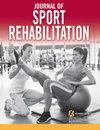Hip Fracture in the Sportive Adult: Case Report of Complete Functional Recovery After Removal of Hardware.
IF 1.3
4区 医学
Q3 REHABILITATION
引用次数: 0
Abstract
CONTEXT Pertrochanteric hip fractures in sportive young adults are mainly caused by a high-energy trauma and treated in the same way as in the older population, using an osteosynthesis immediately followed by a rehabilitation program for several months. The current standard is not to remove osteosynthesis material, similar to the case of older patients. CASE PRESENTATION A 45-year-old male cyclist experienced a right pertrochanteric femoral fracture, treated with cephalomedullary nails. After 9 months of adequate rehabilitation, weakness of the quadriceps musculature and functional complaints persisted, objectified through an isokinetic strength test and a significantly reduced score on the Hip Disability and Osteoarthritis Outcome Score questionnaire. The patient was unable to return to his previous level of cycling performance. MANAGEMENT AND OUTCOME After exclusion of structural bone complications, nerve injury, and central sensitization, the functional complaints and strength deficiency were hypothesized to be related to the osteosynthesis material. Therefore, the hardware was removed 9 months after the first surgery, and the rehabilitation was continued for another 20 weeks. Very soon after the removal of the hardware, the functional complaints disappeared with a remarkable improvement of the Hip Disability and Osteoarthritis Outcome Score. The isokinetic strength test showed complete recovery of muscle strength 20 weeks after osteosynthesis removal, and preinjury cycling performance values were obtained 9 months posthardware removal. CONCLUSION Despite an adequate rehabilitation following a hip fracture, sporty young adults may fail to reach their previous level of functioning. Osteosynthesis removal may be indicated in this sportive population to reach complete muscle strength and functional recovery. The management of hip fractures in the sportive young adult and the identification of patients who may benefit from removal of the hardware require more research.运动型成年人髋部骨折:移除硬件后功能完全恢复的病例报告。
摘要:运动型青壮年髋关节转子前骨折主要由高能量创伤引起,治疗方法与老年患者相同,即立即进行骨合成,然后进行为期数月的康复治疗。目前的标准是不去除骨合成材料,这与老年患者的情况类似。病例介绍一名 45 岁的男性自行车运动员右侧股骨转子前骨折,采用头髓内钉治疗。经过 9 个月的充分康复治疗后,股四头肌无力和功能性不适症状依然存在,具体表现为等动力量测试和髋关节残疾与骨关节炎结果评分问卷的得分明显降低。在排除了骨结构并发症、神经损伤和中枢敏感化等因素后,患者的功能性不适和力量不足被认为与骨合成材料有关。因此,在第一次手术 9 个月后拆除了假体,并继续进行了 20 周的康复治疗。拆除假体后不久,患者的功能性不适症状就消失了,髋关节残疾和骨关节炎结果评分也明显改善。等速肌力测试表明,骨假体取出 20 周后肌力完全恢复,在假体取出 9 个月后,伤前骑自行车的性能值达到了受伤前的水平。对于这类运动人群,可能需要进行骨整合去除术,以达到完全的肌肉力量和功能恢复。如何治疗运动型青壮年髋部骨折,以及如何确定哪些患者可以从取出假体中获益,还需要更多的研究。
本文章由计算机程序翻译,如有差异,请以英文原文为准。
求助全文
约1分钟内获得全文
求助全文
来源期刊

Journal of Sport Rehabilitation
医学-康复医学
CiteScore
3.20
自引率
5.90%
发文量
143
审稿时长
>12 weeks
期刊介绍:
The Journal of Sport Rehabilitation (JSR) is your source for the latest peer-reviewed research in the field of sport rehabilitation. All members of the sports-medicine team will benefit from the wealth of important information in each issue. JSR is completely devoted to the rehabilitation of sport and exercise injuries, regardless of the age, gender, sport ability, level of fitness, or health status of the participant.
JSR publishes peer-reviewed original research, systematic reviews/meta-analyses, critically appraised topics (CATs), case studies/series, and technical reports that directly affect the management and rehabilitation of injuries incurred during sport-related activities, irrespective of the individual’s age, gender, sport ability, level of fitness, or health status. The journal is intended to provide an international, multidisciplinary forum to serve the needs of all members of the sports medicine team, including athletic trainers/therapists, sport physical therapists/physiotherapists, sports medicine physicians, and other health care and medical professionals.
 求助内容:
求助内容: 应助结果提醒方式:
应助结果提醒方式:


